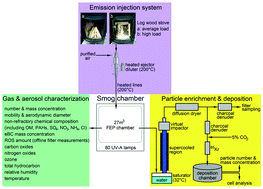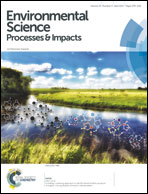Wood combustion particles induce adverse effects to normal and diseased airway epithelia†
Abstract
Residential wood burning is a major source of poorly characterized, deleterious particulate matter, whose composition and toxicity may vary with wood type, burning condition and photochemical age. The causative link between ambient wood particle constituents and observed adverse health effects is currently lacking. Here we investigate the relationship between chemical properties of primary and atmospherically aged wood combustion particles and acute toxicity in human airway epithelial cells. Emissions from a log wood burner were diluted and injected into a smog chamber for photochemical aging. After concentration-enrichment and removal of oxidizing gases, directly emitted and atmospherically aged particles were deposited on cell cultures at the air–liquid interface for 2 hours in an aerosol deposition chamber mimicking physiological conditions in lungs. Cell models were fully differentiated normal and diseased (cystic fibrosis and asthma) human bronchial epithelia (HBE) and the bronchial epithelial cell line BEAS-2B. Cell responses were assessed at 24 hours after aerosol exposure. Atmospherically relevant doses of wood combustion particles significantly increased cell death in all but the asthma cell model. Expression of oxidative stress markers increased in HBE from all donors. Increased cell death and inflammatory responses could not be assigned to a single chemical fraction of the particles. Exposure to primary and aged wood combustion particles caused adverse effects to airway epithelia, apparently induced by several interacting components.



 Please wait while we load your content...
Please wait while we load your content...